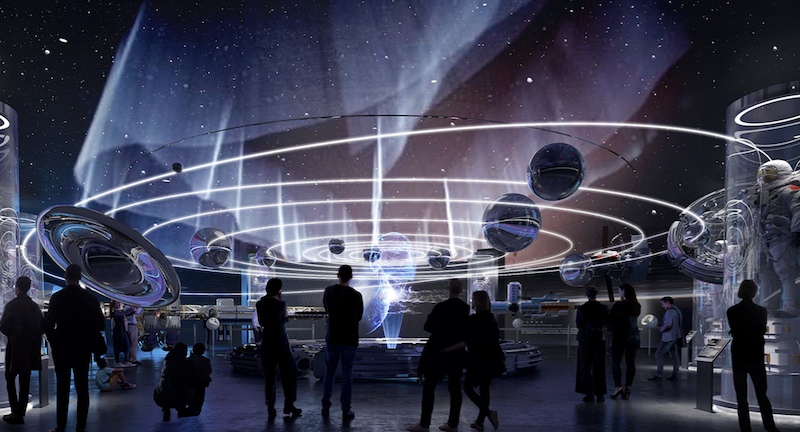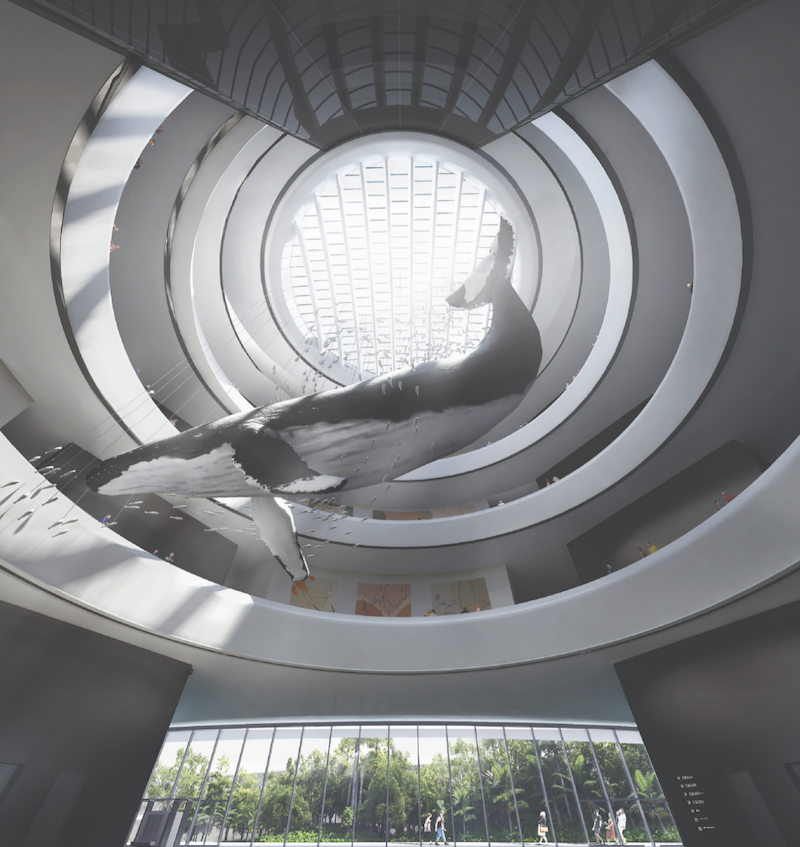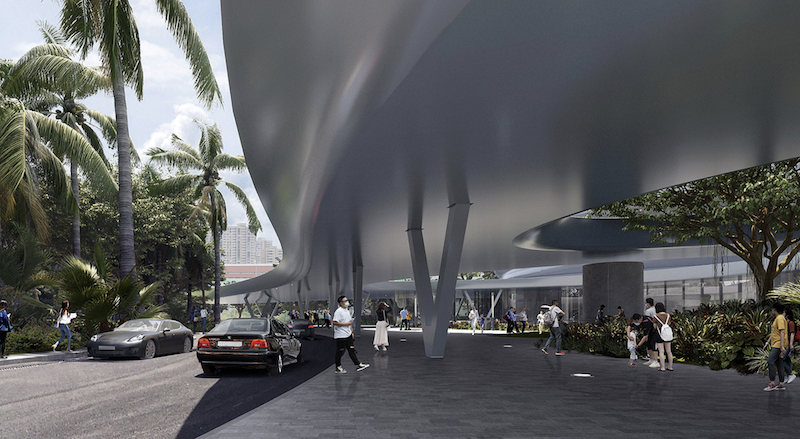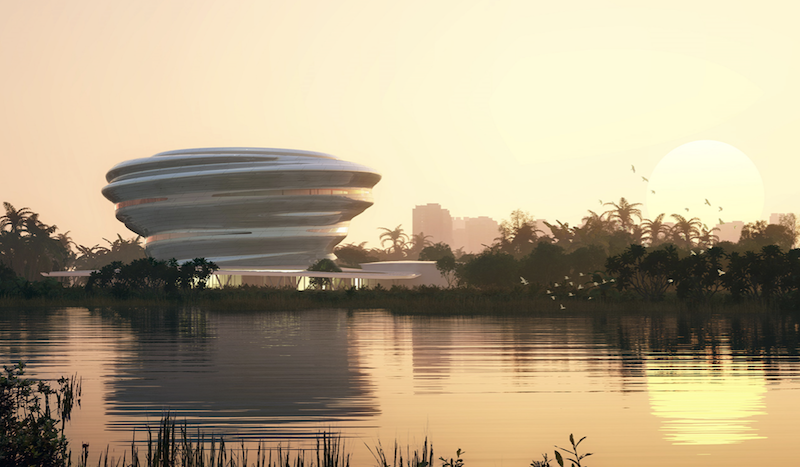MAD Architects has revealed the design for the Hainan Science and Technology Museum, located on Haikou’s west coast in Hainan province, shortly before the project is set to break ground at the end of August.
The 500,000-sf museum draws from the site’s dual urban and natural context, set against the backdrop of a tropical rainforest. The museum’s main pavilion is shaped like a cloud in dialogue with nature. From a distance, the building is designed to emerge from the city, while it will appear to visitors entering the museum area to be floating above the jungle.

About 299,000 sf of the museum’s total area is located above ground and includes permanent exhibition space, a planetarium, a giant-screen theater, and a flying theater. The museum’s interior structure comprises three floor-to-ceiling cores, curved trusses, spiral ramps, and a roof, that are all exposed to achieve harmony between the architectural forms and structural system. A skylight in the museum’s dome bathes the atrium in natural light while a sloping, spiraling exhibition space ascends from the central hall over five floors to connect visitors across the museum.

The exhibition experience begins on the fifth floor where the elevator opens to a 360-degree viewing platform with the sea and cityscape visible in the distance. Visitors on the top floor begin by exploring the technology and space galleries before proceeding down the ramp to the ocean and life science galleries on the fourth floor. The math and science galleries are on the third floor and the multimedia interactive experience area and the children’s playground are on the second floor. As visitors travel down the ramp, the can simultaneously enjoy the scenery and the exhibitions and a gallery running alongside the ramp extends the viewing experience.

The museum’s facade of fiber-reinforced plastic gives the building a distinctive silver, reflective exterior from both near and far. An undulating canopy extends from the main pavilion in all directions to create a space specifically conceived to accommodate the public in Haikou’s humid and rainy climate. The north side of the canopy also hosts the giant screen and flying theater. The southwest corner hosts the planetarium and observatory. Outdoor public spaces include a crater-like sunken plaza and a reflecting pool.
The Hainan Science and Technology Museum is slated for completion in 2024.


Related Stories
| Sep 12, 2011
Living Buildings: Are AEC Firms up to the Challenge?
Modular Architecture > You’ve done a LEED Gold or two, maybe even a LEED Platinum. But are you and your firm ready to take on the Living Building Challenge? Think twice before you say yes.
| Apr 13, 2011
Expanded Museum of the Moving Image provides a treat for the eyes
The expansion and renovation of the Museum of the Moving Image in the Astoria section of Queens, N.Y., involved a complete redesign of its first floor and the construction of a three-story 47,000-sf addition.
| Apr 12, 2011
Entrance pavilion adds subtle style to Natural History Museum of Los Angeles
A $13 million gift from the Otis Booth Foundation is funding a new entrance pavilion at the Natural History Museum of Los Angeles County. CO Architects, Los Angeles, is designing the frameless structure with an energy-efficient curtain wall, vertical suspension rods, and horizontal knife plates to make it as transparent as possible.
| Jan 21, 2011
Sustainable history center exhibits Fort Ticonderoga’s storied past
Fort Ticonderoga, in Ticonderoga, N.Y., along Lake Champlain, dates to 1755 and was the site of battles in the French and Indian War and the American Revolution. The new $20.8 million, 15,000-sf Deborah Clarke Mars Education Center pays homage to the French magasin du Roi (the King’s warehouse) at the fort.
| Jan 19, 2011
Industrial history museum gets new home in steel plant
The National Museum of Industrial History recently renovated the exterior of a 1913 steel plant in Bethlehem, Pa., to house its new 40,000-sf exhibition space. The museum chose VOA Associates, which is headquartered in Chicago, to complete the design for the exhibit’s interior. The exhibit, which has views of five historic blast furnaces, will feature artifacts from the Smithsonian Institution to illustrate early industrial America.
| Jan 19, 2011
Museum design integrates Greek history and architecture
Construction is under way in Chicago on the National Hellenic Museum, the nation’s first museum devoted to Greek history and culture. RTKL designed the 40,000-sf limestone and glass building to include such historic references as the covered walkway of classical architecture and the natural wood accents of Byzantine monasteries. The museum will include a research library and oral history center, plus a 3,600-sf rooftop terrace featuring three gardens. The project seeks LEED Silver.
| Nov 23, 2010
The George W. Bush Presidential Center, which will house the former president’s library
The George W. Bush Presidential Center, which will house the former president’s library and museum, plus the Bush Institute, is aiming for LEED Platinum. The 226,565-sf center, located at Southern Methodist University, in Dallas, was designed by architect Robert A.M. Stern and landscape architect Michael Van Valkenburgh.
| Nov 2, 2010
Cypress Siding Helps Nature Center Look its Part
The Trinity River Audubon Center, which sits within a 6,000-acre forest just outside Dallas, utilizes sustainable materials that help the $12.5 million nature center fit its wooded setting and put it on a path to earning LEED Gold.
| Oct 13, 2010
Tower commemorates Lewis & Clark’s historic expedition
The $4.8 million Lewis and Clark Confluence Tower in Hartford, Ill., commemorates explorers Meriwether Lewis and William Clark at the point where their trek to the Pacific Ocean began—the confluence of the Mississippi and Missouri Rivers.
| Oct 12, 2010
Gartner Auditorium, Cleveland Museum of Art
27th Annual Reconstruction Awards—Silver Award. Gartner Auditorium was originally designed by Marcel Breuer and completed, in 1971, as part of his Education Wing at the Cleveland Museum of Art. Despite that lofty provenance, the Gartner was never a perfect music venue.
















